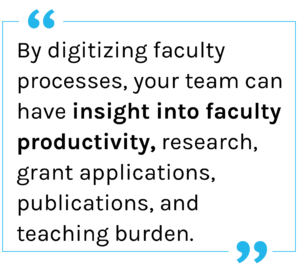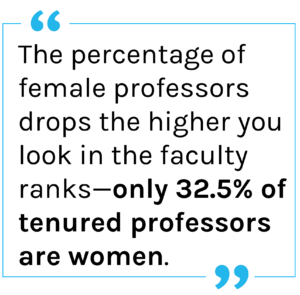Faculty data is underutilized by most colleges and universities.

In fact, a 2020 PeopleAdmin survey revealed that 48% of institutions have predominantly paper faculty processes. Without centralized, accurate data, it’s almost impossible to draw actionable analytic insights—and that means your institution is missing out on a lot of vital information about your faculty body. Read on to learn a few ways that analytics can help you identify gaps in your faculty.
Faculty workloads
Faculty have complex workloads. Their days are made up of teaching, preparing course materials and curricula, advising and meeting with students, research and writing, service work, and huge chunks of hard-to-define administrative work. Service work, student meetings, and planning courses all come with their own additional administrative tasks, like emailing follow-ups or scheduling.
With faculty pulled in so many different directions (and overwhelmed by administration), it’s important for institutions to keep track of what they’re doing and ensure that workloads are distributed equally. By digitizing faculty processes, your team can have insight into faculty productivity, research, grant applications, publications, and teaching burden. The right analytics let academic affairs teams and deans examine these metrics by department or school to see if, for instance, the teaching workload in the math department is distributed unequally.
 Digitization also allows your institution to break down faculty workload using EEO metrics so you can better understand potential inequities. For instance, studies show that there is an unseen gender divide in faculty service at many institutions. Women are asked to (and do) take on more service roles than men, taking away time from their research and teaching but receiving little recognition for sacrificing those hours—in other words, service doesn’t help female professors move up the tenure ladder. The same is true for other underrepresented groups of faculty, who take on an unequal share of the service burden. Faculty often don’t have a good sense of how much service work they should take on, or how much their colleagues are doing—but with a transparent, centralized faculty system, your institution will have insight into service distribution, can root out potential inequities, and can ensure that faculty aren’t asked to take on service that interferes with their other duties.
Digitization also allows your institution to break down faculty workload using EEO metrics so you can better understand potential inequities. For instance, studies show that there is an unseen gender divide in faculty service at many institutions. Women are asked to (and do) take on more service roles than men, taking away time from their research and teaching but receiving little recognition for sacrificing those hours—in other words, service doesn’t help female professors move up the tenure ladder. The same is true for other underrepresented groups of faculty, who take on an unequal share of the service burden. Faculty often don’t have a good sense of how much service work they should take on, or how much their colleagues are doing—but with a transparent, centralized faculty system, your institution will have insight into service distribution, can root out potential inequities, and can ensure that faculty aren’t asked to take on service that interferes with their other duties.
DEI gaps
Another set of metrics that can help your institution discover gaps in your faculty are related to DEI. Paper processes make it difficult to track and measure the progress of diversity, equity, and inclusion (DEI) initiatives, but digitized, interconnected systems offer a great deal of insight. For instance, your team can examine the metrics of your hiring pool for a given position, or drill down into DEI metrics for current employees in a date range, department, school, or campus. Keeping a close eye on hiring, performance ratings, and retention can help you dig into potential inequities or biases playing out in a particular department or school, and identify areas where you need to put DEI initiatives to work.
Gender gaps are still persistent on many campuses. The percentage of female professors drops the higher you look in the faculty ranks—only 32.5% of tenured professors are women. In addition, certain disciplines are still facing huge gender inequities: while 48% of humanities professors are women, only 21% of STEM professors are women. These gender gaps seem obvious from national numbers, but on your campus, they might not be clear until you dig into your metrics. It’s important to look closely at EEO breakdowns in every department and school to pinpoint gaps in your faculty.
professors are women. In addition, certain disciplines are still facing huge gender inequities: while 48% of humanities professors are women, only 21% of STEM professors are women. These gender gaps seem obvious from national numbers, but on your campus, they might not be clear until you dig into your metrics. It’s important to look closely at EEO breakdowns in every department and school to pinpoint gaps in your faculty.
Promotion and tenure
Promotion and tenure processes take up huge chunks of faculty time. Tracking work history and achievements, personalizing dossiers, and pulling together the huge amounts of information required for tenure review can be daunting, and takes faculty away from the workload they’re already struggling with.
On top of that, there is still bias in the tenure process in HigherEd. According to Inside Higher Ed, “Almost three-quarters of black, Asian and Latinx professors reported ‘feeling a need to work harder than their colleagues to be seen as legitimate scholars.’”
In addition, female faculty members can struggle to stay on the tenure track due to “leaky pipeline” issues which have been exacerbated by the pandemic. Female faculty were disproportionately impacted during COVID, sacrificing research to balance increased caregiving responsibilities and core faculty responsibilities. Women academics also published fewer papers than men during the pandemic—and research is vital for any professor hoping to get tenure.
With a fully digital tenure process, you can directly impact these issues. First, digitized processes ease the burden and stress of tenure review for faculty because all their information is already in one place. When tenure review is digital, it’s also transparent and easy to examine—so your institution can track and eliminate biases, leaky pipelines, and unequal workload and research expectations that are leading to gaps in your tenured faculty body.
Final thoughts
If you’re still using paper processes for faculty, there are so many insights you’re missing out on that can help your faculty be more productive and more supported. With burnout and resignation rates still high among college and university professors, now is the time to prioritize your faculty. Schedule a demo with PeopleAdmin today to learn more about faculty digitization.